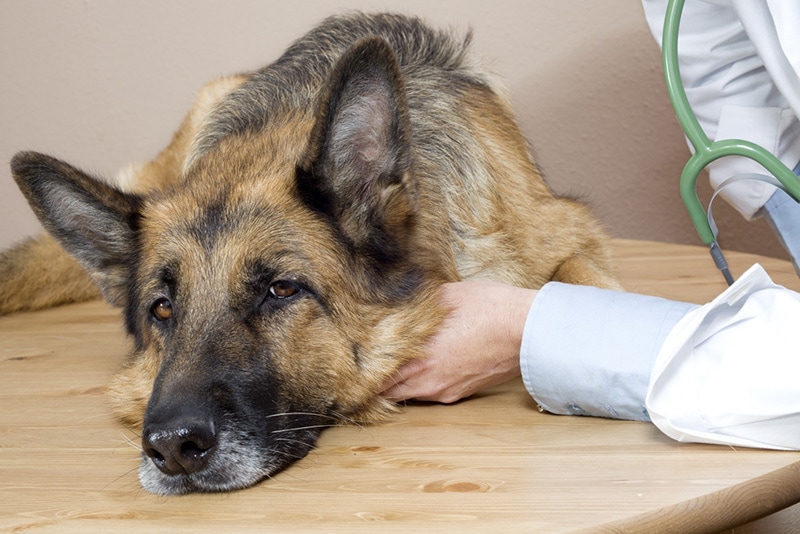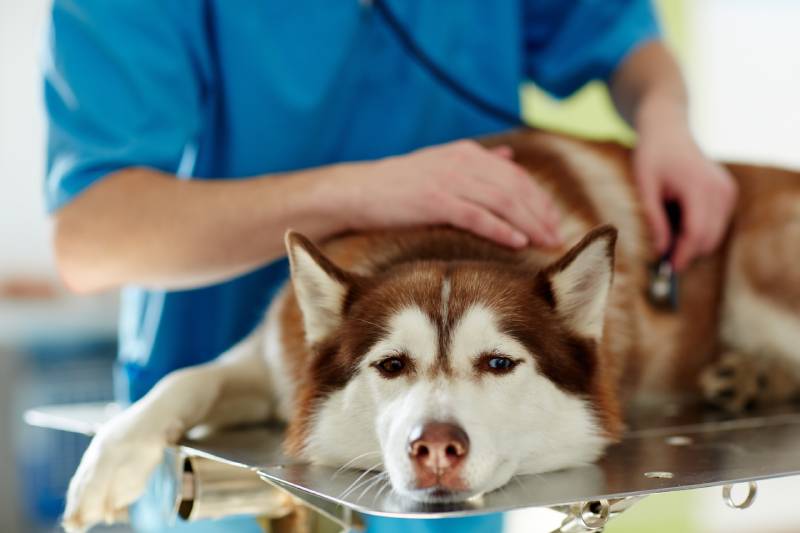In this article
Having a dog with diabetes mellitus calls for constant observation and care. It is difficult to see your beloved pet battling a chronic illness, and identifying signs of suffering can be difficult to accept. Diagnosing dogs with diabetes mellitus may not occur until serious illness occurs, whereas others may be treated for the disease but poorly regulated.
Unfortunately, diabetes mellitus is incurable, and dogs battling this may develop complications that are life-threatening. Below are signs your pet may experience as they approach the end stage of diabetes mellitus.
If you need veterinary advice for your pet, we recommend PangoVet’s TeleVet service. You can have a video consultation with a real veterinarian from the comfort of wherever you are, no travel needed. PangoVet’s vets can provide you with personalized care and advice, and hopefully help ease your mind.

If you want to speak with a vet online, head to PangoVet and get the personalized advice you need for your pet — all at an affordable price!
Please note that PangoVet does not offer prescriptions and is not for medical emergencies.

As a Review
Diabetes mellitus is an endocrine disorder of the pancreas that is defined by poor control of glucose levels. Destruction of pancreatic cells responsible for insulin production is the most common cause of diabetes mellitus in dogs. Decreased insulin production allows higher-than-normal levels of glucose to circulate in the blood. When this occurs, patients develop signs of weight loss, increase in water intake and urination, cataract formation, and, in some situations, complicating secondary conditions.
Diabetes mellitus is often diagnosed in dogs by evaluation of blood and urine when supportive clinical signs are noticed. Dogs with diabetes mellitus can be treated with insulin injections, exercise, and a strict diet. Unfortunately, not every owner is able to treat their dog for diabetes, and some dogs become severely ill prior to receiving a diagnosis.
Dogs that do not receive treatment for diabetes mellitus quickly deteriorate, whereas dogs with strict treatment could live for years after diagnosis. Concurrent medical conditions and patient age must also be taken into consideration when determining overall life expectancy and prognosis.

Complications
There is a risk of hypoglycemia (too low of glucose) in dogs being treated with insulin. Hypoglycemia can occur if too much insulin is administered. When this occurs, signs like weakness, lethargy, vomiting, and seizures may be noted.
Alternatively, diabetic ketoacidosis is a complication that patients with prolonged hyperglycemia (elevated glucose in the blood) experience. When insulin is not available to pull glucose into the cells to use as a fuel source, the body is forced to create ketones from fat stores as an emergency fuel source.
This activity is appropriate in the short term; however, prolonged periods of ketone usage lead to the body becoming acidotic. When this occurs, electrolyte imbalances and severe dehydration result. Diabetic ketoacidosis is a life-threatening complication that requires hospitalization and intensive care.
Similarly, another complication exists that is far less common but just as life-threatening, called hyperglycemic hyperosmolar syndrome (HHS). This condition is not fully understood but is similar to diabetic ketoacidosis; however, the body doesn’t produce ketones due to some insulin availability in the body. Patients with this condition also need immediate veterinary care and hospitalization to correct fluid abnormalities.
Diabetes mellitus is a disease that requires very close monitoring, precise care, and an understanding of possible complications. Clinical signs for diabetics can often be improved with appropriate care, but signs may resurface, be uncontrollable, or lead to other complications. When this occurs, quality of life comes into question.

The 7 Signs Your Dog with Diabetes Is Dying
1. Weakness
If a diabetic dog is showing signs of weakness, it could be due to hypoglycemia or potentially ketoacidosis, along with several other possible ailments. Patients experiencing weakness will often be lethargic or difficult to arouse.
Weakness is not specific to a certain illness; therefore, a veterinarian will need to evaluate your pet and perform diagnostics to determine the underlying cause.
2. Seizures
Seizures that occur in a diabetic patient can be due to hypoglycemia and can also be seen with hyperglycemia. Any seizure activity that occurs in a diabetic pet or an undiagnosed diabetic dog needs immediate veterinary attention.

3. Chronic Vomiting
Diabetic dogs may exhibit vomiting with either hypoglycemia or hyperglycemia. If vomiting is noted in your pet, a prompt vet visit should be scheduled. This will likely entail blood work that can be used to help identify ketoacidosis or any other underlying conditions.
4. Decreased Appetite
A predictable appetite is necessary in a diabetic patient. Patients being treated with insulin are usually on a strict feeding schedule, and a change in appetite influences the safety of insulin administration. If your animal is exhibiting a decreased appetite, this could be a sign that their condition is deteriorating.

5. Excessive Water Intake/Urination
Dogs with diabetes often drink excessively and urinate excessively, secondary to the increased levels of glucose in their blood and glucose being excreted in their urine. As patients are treated for diabetes mellitus with insulin, this sign can be improved. However, a poorly regulated diabetic will have a recurrence of signs.
If your beloved pet is suddenly experiencing a sudden increase in water intake and urination, it could also be a sign of DKA or a urinary tract infection.
6. Recurrent Infections
Diabetic dogs eliminate glucose in their urine. Having glucose, or sugar, in the urine is supportive for the development of urinary tract infections. Dogs suffering from UTIs will generally drink more and urinate more often. A urinalysis and culture can be done to confirm the diagnosis, and appropriate treatment can be initiated.
Infections also lead to insulin resistance secondary to stress, making clinical signs of diabetes more difficult to control.

7. Weight Loss
Dogs experiencing uncontrolled weight loss should be closely evaluated. In diabetic patients, fat is quickly broken down as an energy source, leading to weight loss. Dehydration, a common complication of diabetes mellitus, also contributes to weight loss.
If you’re concerned about your pet’s well-being, we recommend consulting a veterinarian.

When Should Euthanasia Be Considered?
Seeing your beloved companion show signs of illness can be heartbreaking. Once a diagnosis has been determined for your pet, it is important to know what to monitor for that may illustrate a worsening in their condition. But when is enough enough? Most families monitor overall quality of life. It can be helpful to use this worksheet provided by Lap of Love as a guideline to help determine if patient suffering is present.
In animals with an incurable disease like diabetes mellitus, it’s important to understand that the best-case scenario is the prolonged reduction in clinical signs and patient comfort. When clinical signs are persistent and negatively impact a patient’s quality of life, it is time to start discussing humane euthanasia.


Conclusion
Diabetes mellitus is a condition that can be managed but not cured. Monitoring clinical signs closely will be the best way to determine if your dog’s condition is deteriorating. In some cases, the patient’s quality of life can be improved with additional interventions. Unfortunately, as a patient’s disease progresses, this may become more and more difficult to achieve.
Although preparing to say goodbye to your pet is unmeasurably difficult, alleviating signs of suffering through euthanasia is a selfless act. Your veterinarian will be able to help guide you with end-of-life decision-making for your four-legged companion.
Featured Image Credit: SeventyFour, Shutterstock


















